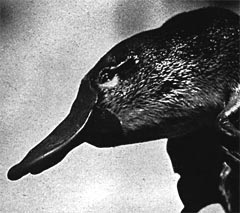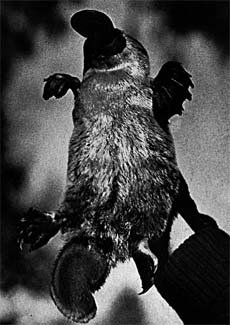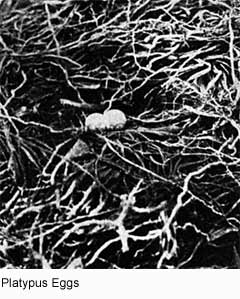|

Not So Warm-blooded: The platypus's body temperature averages 32 °C (90 °F) rather than the 38 °C (100 °F) typical of placental mammals. The extent to which this is a characteristic of monotremes, as opposed to an adaptation on the part of the small number of surviving species to harsh environmental conditions, is uncertain.
 Just the Facts: The body and the broad, flat tail of the platypus are covered with brown fur that traps a layer of insulating air to keep the animal warm. Like the Tasmanian Devil, the platypus uses the tail for fat storage. It has webbed feet and a large, rubbery snout that are more reminiscent of a duck's features than those of any known mammal. The snout does not open like a bird's beak, with both the upper and lower parts of the beak separating to reveal its mouth. The platypus snout is a sensory organ with an opening on the underside. Just the Facts: The body and the broad, flat tail of the platypus are covered with brown fur that traps a layer of insulating air to keep the animal warm. Like the Tasmanian Devil, the platypus uses the tail for fat storage. It has webbed feet and a large, rubbery snout that are more reminiscent of a duck's features than those of any known mammal. The snout does not open like a bird's beak, with both the upper and lower parts of the beak separating to reveal its mouth. The platypus snout is a sensory organ with an opening on the underside.
Weights and Measures: Weight varies considerably between less than 1 kg (2.2 lb) to more than 2 kg (4.5 lb); its body length ranges from 30–40 cm (11-16 inches), and its tail length from 10–15 cm (4-6 inches) for males and 8–13 cm (3-5 inches) for females. Males are around a third larger than females. There is substantial variation in average size from one region to another, though oddly this pattern does not seem to follow any particular climatic rule.
Strange Strut: The platypus has extra bones in the shoulder girdle, including an interclavicle, which is not found in other mammals. It also has a reptile-like gait, with legs that are on the sides of the body, rather than underneath. The platypus maneuvers with its flat tail and hind feet, which allows it to dive quickly and stabilize itself.
 Watch Out for the Spur! The male platypus has venomous ankle spurs, used in vicious territorial battles and fights over mates. The venom is not normally lethal to humans but produces excruciating pain and swelling that lasts for several months. The pain is so intense that the victim is rendered almost helpless. The venom can be lethal to dingos, dogs and smaller domestic animals. Watch Out for the Spur! The male platypus has venomous ankle spurs, used in vicious territorial battles and fights over mates. The venom is not normally lethal to humans but produces excruciating pain and swelling that lasts for several months. The pain is so intense that the victim is rendered almost helpless. The venom can be lethal to dingos, dogs and smaller domestic animals.
Venom is produced in the crural glands of the male during the breeding season and is aggressively inflicted through a calcaneus spur on each hind limb. Females, like echidnas, have rudimentary spur buds which do not develop and do not have functional crural glands.
In humans the most remarkable symptom is immediate and extreme pain. Oedema rapidly develops around the wound and gradually spreads throughout the affected limb. Information obtained from case histories and anecdotal evidence indicates that the pain develops into a long-lasting hyperalgesia that persists for days or even months.
Electro-what?!? The platypus is one of the few mammals known to have a sense of electroception: it locates its prey in part by detecting their body electricity. Its electroception is the most sensitive of any mammal.
How They Feed: The platypus feeds by digging in the bottom of streams with the bill. The electroreceptors could also be used to distinguish animate and inanimate objects in this situation (in which the mechanoreceptors would  be continuously stimulated). Much of this is speculation, and there is still much to be learned about electroreception in the platypus and its fellow monotreme, the echidna. be continuously stimulated). Much of this is speculation, and there is still much to be learned about electroreception in the platypus and its fellow monotreme, the echidna.
Strangeness Upon Strange: Studies of the concentration of minerals in the blood of the platypus have shown that it has an incredibly high concentration of vanabins and other vanadium-based compounds.
The mechanisms that cause the absorption are not known, though other aquatic animals, including tunicates, also show this behavior. It also has an extremely high concentration of mercury in its blood compared to other mammals.

Platypus in Trouble: The platypus is semi-aquatic, inhabiting small streams and rivers over an extensive range from the cold highlands of Tasmania and the Australian Alps to the tropical rainforests of coastal Queensland as far north as the base of the Cape York Peninsula. Inland, its distribution is not well known: it is extinct in South Australia (bar an introduced population on Kangaroo Island) and is no longer found in the main part of the Murray-Darling Basin, probably because of the declining water quality brought about by extensive land clearing and irrigation schemes.
Habitat and Home: Along the coastal river systems, its distribution is unpredictable; it appears to be absent from some relatively healthy rivers, and yet maintains a presence in others that are quite degraded (the lower Maribyrnong, for example). The platypus is generally regarded as nocturnal, but is commonly active at dawn and dusk, and many individuals are also active during the day, particularly on cloudy days.
Platypus Paddling: The platypus is an excellent swimmer and spends much of its time in the water foraging for food. When swimming they are distinguished from other Australian mammals by the absence of visible ears. It keeps its eyes tightly shut when swimming, relying completely on its other senses. All four feet of the platypus are webbed. When it swims, it propels itself by paddling with the front two feet. The tail and hind feet assist in steering but not propulsion.

Do the Surface and Chew:
It may be observed that, when the platypus dives, it sends up a bubble of air after approximately some time, then some time later it sends up another bubble of air, and some additional time after that, it surfaces, lies spread-eagled on the top of the water, and chews its food. Then it dives again.
A normal dive lasts between 30 seconds and a minute, but can last longer in favorable conditions. 10-20 seconds are commonly spent on the surface chewing.
Hungry, Hungry Platypus: The platypus is a carnivore. It feeds on annelid worms and insect larvae, freshwater shrimps, and yabbies (freshwater crayfish) that it digs out of the riverbed with its snout or catches while swimming. Its bill is very sensitive, allowing it to hunt its food without using sight. The platypus needs to eat about 20% of its own weight every day. This requires the platypus to spend about 10 hours each day looking for food. When not in the water, the platypus retires to a short, straight burrow of oval cross-section, nearly always in the riverbank not far above water level, and often hidden under a protective tangle of roots.

 Birds and Bees: The species exhibits a single breeding season, with mating occurring in late winter or spring and young first emerging into the water after three to four months of nurture by the lactating females in the nesting burrows. Historical observation, mark and recapture studies and preliminary investigations of population genetics indicate the possibility of resident and transient members of populations and suggest a polygamous mating system. Birds and Bees: The species exhibits a single breeding season, with mating occurring in late winter or spring and young first emerging into the water after three to four months of nurture by the lactating females in the nesting burrows. Historical observation, mark and recapture studies and preliminary investigations of population genetics indicate the possibility of resident and transient members of populations and suggest a polygamous mating system.
Single Mothers: Outside the mating season, the platypus lives in a simple ground burrow whose entrance is about 30cm (one foot) above the water level. After mating, the female constructs a deeper, more elaborate burrow up to 20 m long and blocked with plugs at intervals as a safeguard against rising waters.
The male takes no part in caring for its young, and retreats to its yearlong burrow. The female softens the ground in the burrow with dead, folded, wet leaves and she fills the nest at the end of the tunnel with fallen leaves and reeds for bedding material. This material is dragged to the nest by tucking it underneath her curled tail.
 They Lay Eggs! The platypus lays small, leathery eggs similar to those of reptiles, which are slightly rounder than bird eggs. Females usually lay two eggs at a time, but sometimes they lay one egg or three, which are about 11 mm (7/16 inch) in diameter. They Lay Eggs! The platypus lays small, leathery eggs similar to those of reptiles, which are slightly rounder than bird eggs. Females usually lay two eggs at a time, but sometimes they lay one egg or three, which are about 11 mm (7/16 inch) in diameter.
After laying her eggs, the female curls around them. The incubation period is separated into three parts. In the first, the embryo has no functional organs and relies on the yolk sac for respiration. During the second, the fingers and toes appear, and in the last, the egg tooth appears. When the eggs hatch after an incubation period of roughly ten days, the small hairless young cling to the mother.
Born in the Burrow: The newly hatched young are vulnerable, blind, and nude, and are fed by the mother's milk. The milk is released through pores in her abdomen. There are grooves on her abdomen that form pools of milk, allowing the young to lap up the milk. After the eggs hatch, the mother leaves the burrow only for short periods of time to feed and wet her fur. When the mother leaves her young, she plugs the entrance with soil to protect her offspring. The offspring are suckled for three to four months after they have hatched. They leave the burrow when they are seventeen weeks old.

 Misunderstood Mammals: The platypus and other monotremes were very poorly understood for many years, and to this day some of the 19th century myths that grew up around them endure, for example, that the monotremes are "inferior" or quasi-reptilian, and that they are the distant ancestor of the "superior" placental mammals. Misunderstood Mammals: The platypus and other monotremes were very poorly understood for many years, and to this day some of the 19th century myths that grew up around them endure, for example, that the monotremes are "inferior" or quasi-reptilian, and that they are the distant ancestor of the "superior" placental mammals.
It is now known that modern monotremes are the survivors of an early branching of the mammal tree; a later branching is thought to have led to the marsupial and placental groups.
All text is available under the terms
of the GNU Free Documentation License
|